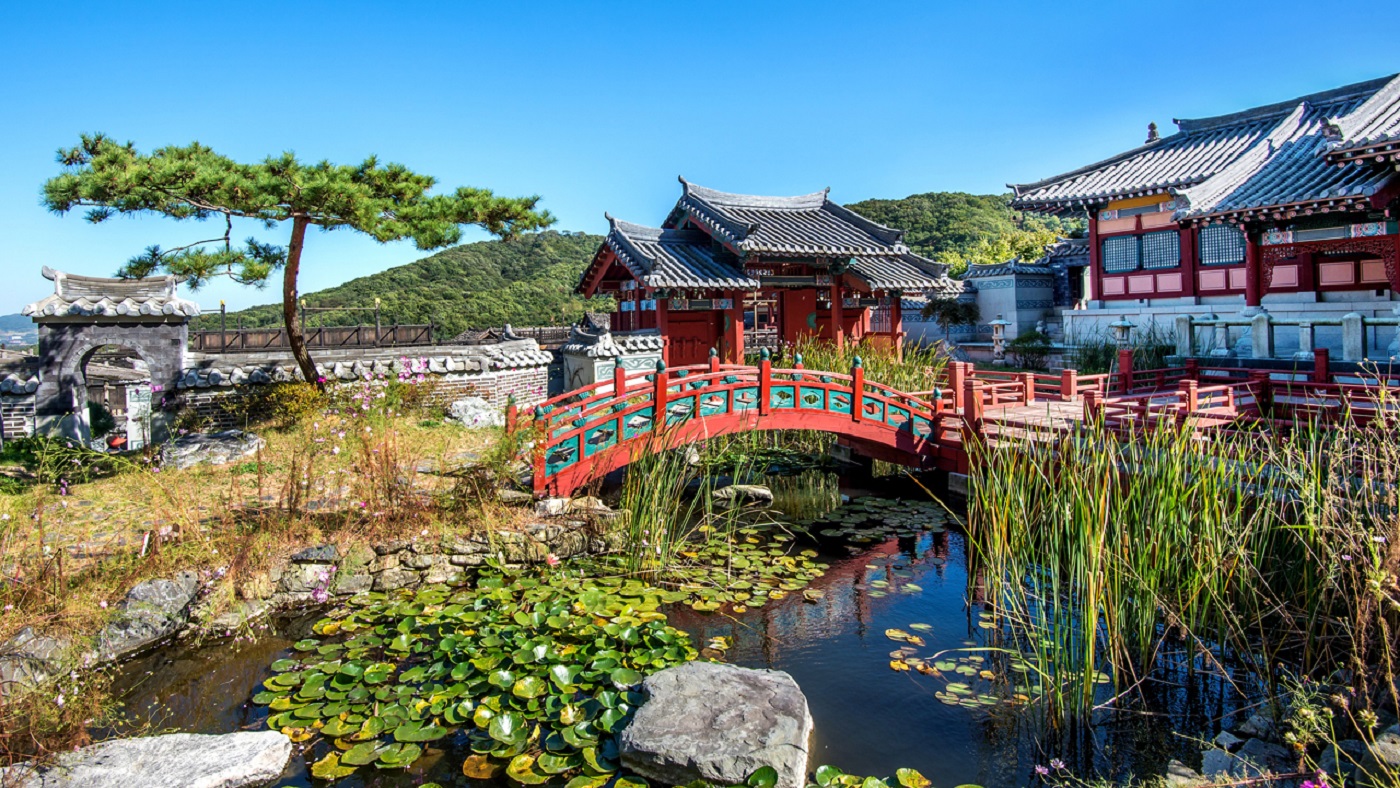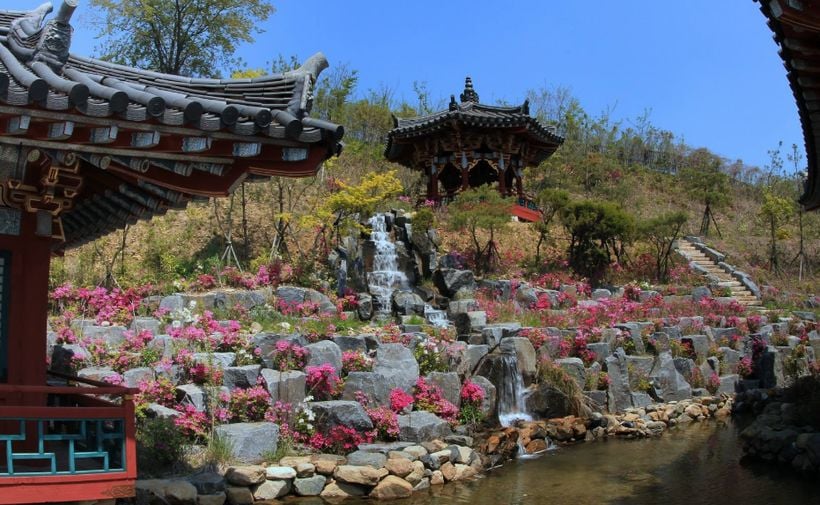Of the many sub-genres and styles of K-dramas, we’re always up for a good sageuk: the intriguing plots of political power struggles and dreamy royal romances never fail to leave us addicted, binge-watching episode after episode. Set in both sprawling palace grounds and humble traditional villages, you’ll feel as if you’ve been transported back in time to the Joseon Dynasty. Well, did you know that you can actually experience the enchanting scenes of your favourite period K-dramas in person?
Many sageuks were shot in existing historical landmarks or similar places, and are a great way to learn more about the various dynasties of Korea’s past. You can even participate in traditional ceremonies or admire these stunning landscapes in Seoul and the surrounding regions.
1. Hyangwonjeong Pavilion in Gyeongbokgung Palace, Seoul

The beautiful pavilion was built on an artificial island in the middle of Hyangwonji pond by King Gojong during the 10th year of his reign in 1873. This was the same time Geoncheonggung Residence was being built.
The bridge, which allows private access to the island, is known as Chwihyanggyo Bridge. The original bridge was located on the opposite side of the island and was constructed only of wood. At the time, it was one of the longest wooden bridges.
While visiting Gyeongbokgung Palace, take some time to explore its idyllic pavilions and ponds. The beautiful Hyangwonjeong Pavilion sits atop a private island accessible from the palace grounds by the Chwihyanggyo Bridge, and used to be the king’s informal place for rest and leisure.
2. MBC Dae Jang Geum Park, Yongin

The complex was opened to visitors and tourists in June 21, 2011 for the first time. Recently in 2015, it was renamed to its current name Yongin Daejanggeum Park, based on the titular character of MBC’s 2003 historical drama Dae Jang Geum for promotional reasons.
Take a trip through ancient history at Dae Jang Geum Park, a hallyu theme park which transports you back into the past. The park is the largest historical drama set in Korea, reconstructing the traditional architecture, household items, and lifestyle of the Goryeo and Joseon kingdoms. It was also a filming location for numerous period dramas, such as Empress Ki and Moon Embracing the Sun.
3. Namsangol Hanok Village, Seoul

The location of the village was originally the site of a well known Joseon-era summer resort called Jeonghakdong. Jeonghakdong means “The land of the fairies for the blue crane where the Jeonugak Pavilion stands along the stream in the valley”. The area boasted such superb scenery that it was called the land of the fairies and was considered one of the five most beautiful parts of Seoul.
A traditional Korean style garden, complete with a flowing stream and pavilion was constructed on the site in order to revive the classical feel of the Joseon-era. Five traditional houses, including some of the residences of high government officials – some of the largest mansions in Seoul at the time, along with commoners houses were moved to the 7,934 sq Meters/9,489 sq Yards grounds containing the restored village.
Namsangol Hanok VIllage is best known for its delicate restoration of traditional Korean hanoks (traditional Korean houses). You’ll get a real taste of village life by exploring the interiors of commoner’s houses and the residences of high government officials, in the natural tranquillity of the surrounding forests and Namsan Mountain nearby. If you’d like to escape the crowds at Bukchon Hanok Village, then head over here instead!
4. Donggung Pae and Wolji Pond, Gyeongju

Anapji was originally located near the palace of Silla called Banwolseong. It is written in Samguk Sagi: “During the era of King Munmu, a new pond was made in the palace and flowers and birds flourished in this pond”. There is also mention of a royal reception held by King Gyeongsun in 931, when Silla was already crumbling. After the fall of Silla, the pond fell into disrepair for many centuries. The name Anapji appears in the 16th century Joseon era document Augmented Survey of the Geography of Korea (hangul:동국여지승람, hanja:東國輿地勝覽) with the explanation that King Munmu made the pond with Taoist aesthetics.
Gyeongju Doung Palace and Wolji Pond was a secondary palace site and home to the Crown Prince of Silla. The site is part of the Gyeongju National Park and a spectacular re-construction of regal Silla architecture. The main attraction is the crown prince’s palace, but historical relics excavated from the site are also on display at the Anapji Exhibition Hall. It offers an insightful experience into life during the Silla Dynasty in the Three Kingdoms period, as seen in dramas such as The King’s Dream and The Emperor of the Sea.
5. Shilla Millennium Park, Gyeongju

Shilla Millennium Park is a theme park integrating both education and entertainment about the history and culture of the Silla Period. Focusing on the Silla Period (57 BC – AD 935), the park reproduces Silla architecture and a village of aristocrats, tells children fun stories about the period, and offers symbolic architecture such as Emile Tower and Seokbinggo. Visitors are also invited to participate in things such as the Craft Clinic.
Who can forget the iconic K-drama featuring the powerful and regal ruler of Silla Dynasty, Queen Seondeok? It’s certainly not an era that’s been lost to time, since the Shilla Millenium Park recreated architecture from the Shilla Dynasty so detailed, it was used as the filming set for the drama. Steeped in history and culture, visitors can learn more about Korea’s past with this visually arresting, interactive park.
5 Famous Historic Places I want To Visit During My Trip In South Korea (Summary)
1. Hyangwonjeong Pavilion in Gyeongbokgung Palace, Seoul
2. MBC Dae Jang Geum Park, Yongin
3. Namsangol Hanok Village, Seoul
4. Donggung Pae and Wolji Pond, Gyeongju
5. Shilla Millennium Park, Gyeongju
References:
- https://www.shutterstock.com/video/clip-29284738-time-lapse-autumn-hyangwonjeong-pavilion-gyeongbokgung-palace
- https://www.theseoulguide.com/sights/palaces/gyeongbokgung-palace/hyangwonjeong-pavilion/
- https://www.tripzilla.com/kto-cultural-places-to-visit-in-korea/85975
- https://en.wikipedia.org/wiki/Donggung_Palace_and_Wolji_Pond
- https://english.visitkorea.or.kr/enu/ATR/SI_EN_3_1_1_1.jsp?cid=264620

